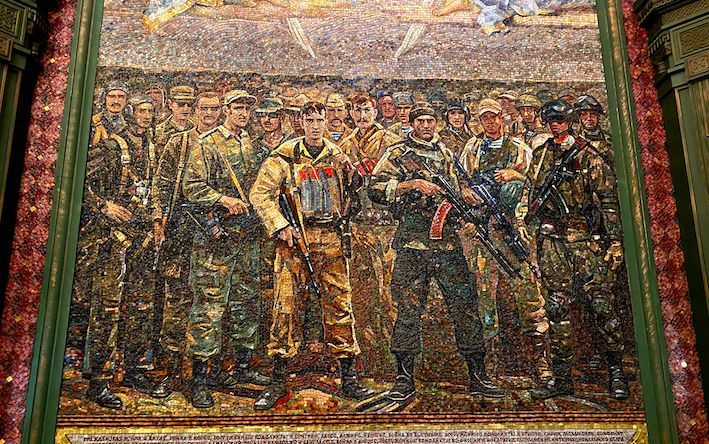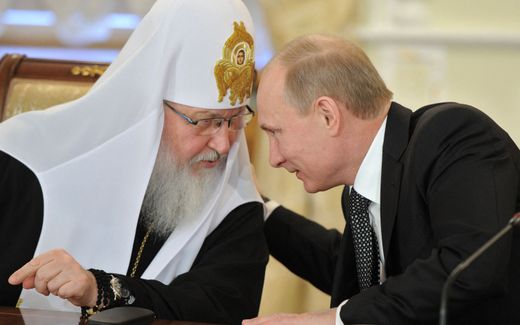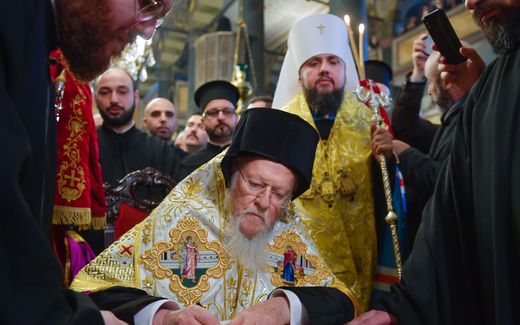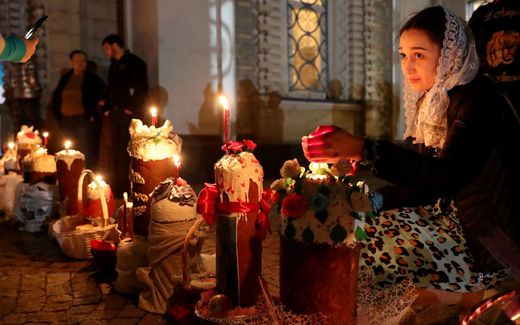Special church for Russian forces: Saying a prayer between guns and icons
26-12-2022
Eastern Europe
William Immink, CNE.news

No saints but heroes in the mosaic. Photo William Immink
Eastern Europe
Every Russian should feel at peace in the Temple of the Russian Armed Forces. “I can feel the patriotism here”, a visitor says. The military operation in Ukraine, however, gives the church a more sombre touch.
In 2020, this church was consecrated in the outskirts of Moscow. It is meant to stimulate the Russian love for the motherland and to encourage soldiers.
At first sight, you would not say this khaki-green building is a church. In wintertime, it looks very dark. It stands in the woods, not far from the Russian capital. But the golden domes give proof: this is a Russian Orthodox Church.
But this big green church is not just any church. Since 2020, it has been the main Temple for Orthodox Russia, honouring the Russian Armed Forces. Surrounding the building is the vast Patriot Park. A huge triumphal arch gives access to the park. A fresh pot of khaki-green paint at the foot of one of the pillars shows that this has only recently been completed.
Visitors
Just as dark as the khaki-green temple, so is the weather on this grey day. The drizzling rain does not stop visitors from visiting this place. Some even come from afar, such as Margarita from Saint Petersburg. “I can feel the patriotism here,” says the lady in her fifties: “And it makes me proud of my country.”
She has every reason to be proud: both her grandfather and that of her husband (Viktor Mikhailovich) fought and died in World War II, or as she calls it: The Great Patriotic War. Viktor and Margarita sent the portraits of their grandfathers to be hung along the 1,418-meter-long Road of Remembrance. That is one meter for each day the war lasted, a war in which many millions of Russians lost their lives.
“We think it is essential to pass on the memory (of the war). My sons have not been here yet, but I would like them to come here sometime,” says Margarita. “Hopefully, nothing like this ever happens again.”
The fact that there is a war in Ukraine at the moment touches her heart. “As a mother of two sons, I only think of other mothers who lost their sons in the war.” She quickly swallows in words about politics. “I just hope it can be over soon,” is her humane conclusion.
Patriotism
Despite the rain, a hundred cars are still in the large parking lot. The vast parking place proves that with better weather and on special occasions, many Russians visit this place. Grumpy guards in camouflage uniform direct visitors to the entrance, where a bus with adolescent students has just stopped. A visit to the khaki-green temple has become part of the school program in the Moscow region.
No entrance without a security check. All bags and people go through a detector gate. After the examination are speakers that give voice to an Orthodox male choir.
A visitor in army clothing introduces himself as Pyotr: “The temple is a bit too dark for me”, he says. “Traditionally, Orthodox temples were white, in combination with light colours. There are no churches with dark colours. But this temple is green.”
His friend Dimitri is more optimistic: “I drove past it once one evening. With the lights on it, it looked impressive: the light makes it look gold.”
Architecture
In the Temple of the Armed Forces, two important parts of modern Russian identity emerge. There is Russian Orthodoxy, with conservative values such as family, fidelity, and faith on one side. On the other side, the great Russian battles culminating in the victory during The Great Patriotic War as a banner of patriotism and love for the Russian motherland.
This way, every Russian can feel comfortable in this Orthodox centre. As Pyotr put it: “I came here not so much for the Orthodoxy as for the architecture. Because it’s beautiful here.”
Indeed, everything has symbolism in the cathedral. The bell tower, for example, is 75 meters high – since, in 2020, it was 75 years since the Germans were defeated. The highest dome reaches 96 meters – because in 960, Vladimir the First was born, the monarch who baptised Russia Orthodoxy. Even the floor on which the pilgrims, clergy, and visitors walk has symbolism: Iron used by “fascists” in World War II was melted down for it.
“All who take the sword shall perish by the sword,” Christ’s words adorn a mosaic of well-armed and well-equipped Red Army soldiers on the church wall. A mosaic a little further on, also with Soviet soldiers, lists Russia’s victories. The last battle won is called “the reunification of Crimea”. A blank line is left open for future wins…
However, Russian patriotism and Orthodoxy sometimes turn out to be cringing. Red hammer-and-sickle flags recall a time when the Communist state persecuted even Orthodoxy itself. Interestingly, the same ‘devilish’ five-point star symbol is portrayed in the cathedral’s stained-glass windows. Victories of great Russian generals like Aleksandr Nevsky and Dmitri Donskoi are mentioned in one breath with the fall of Berlin in 1945.
If anything, this Russian Orthodox cathedral shows Russia’s struggle with its history, which it does not want to forget at all costs.
Riot over Putin icon
Just before the Main Temple of the Armed Forces opened, it was announced that a mosaic would also appear on one of the walls honouring the reunification of Crimea with Russia. Among others, President Putin would be seen there with popular Defence Minister Sergei Shoigu. People stood with Russian flags, and a banner said: “The Crimea is ours.” But the church decided to take it away after a fierce backlash from Russian society.

The portrait of Stalin also had to give way. Leonid Kalinin, the chairman of the committee that dealt with the arts in the temple, thought it was unfair: “The temple was made in memory of the heroes and in honour of the great Victory.” Yet mosaics of both Putin and Stalin in a Russian Orthodox church proved a step too far, even for Putin himself: “Someday grateful future generations will appreciate our achievements, but it is still too early for this,” President Putin said according to his spokesperson.
The church cost more than six billion rubles (100 million euros). About half came from voluntary Russian contributions; the Moscow City Council and the surrounding Moscow Oblast region funded the other half.
Park Patriot
The Temple of the Armed Forces does not stand alone. The church is in the midst of a large park called Park Patriot, which contains various museums. A World War Two battleground is displayed on a field just behind one of the museums: trenches, destroyed German tanks and burned trees are all around. A sign reads in German, “Gott mit uns” – God is with us. A little further on, wax figures of heroic Soviet soldiers, almost lifelike, fire artillery guns.
Across the vast plaza between the triumphal arch and the temple, Orthodox chants blare through the loudspeakers on lampposts every twenty meters. Two (real) soldiers walk across the square with bottles of ‘holy water’ that they tapped in the temple. Along the square are several eateries with shawarma, pelmeni and real Russian army porridge, with an army green artillery gun next to it.
The whole place is designed to give the visitor a patriotic feeling: love for the fatherland, pride in the victory over Nazi Germany and faith in Russian Orthodoxy. Especially at this time, when again, after more than three-quarters of a century, the European front sees itself in a hot war.
Related Articles





